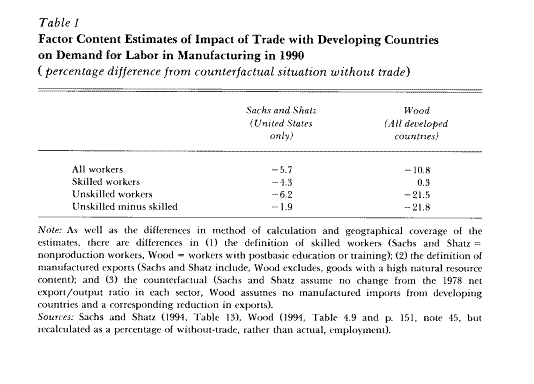Working out the factor content of trade is a common way to examine the effect of trade on labour markets. It calculates how much skilled and unskilled labour is used in producing a country's exports and how much would have been used to produce its imports. The difference between exports and imports is then interpreted as impact of trade on demand for skilled and unskilled workers, by comparison with what it would have been in the absence of trade.
The table below shows two different methods of factor content estimates, one from economists Sachs and Shatz, one from Wood. Firstly looking at the Sachs and Shatz version.(15)
It shows the estimated impact of the 1978-1990 change in trade on unemployment of skilled and unskilled (non production and production) workers in the United States manufacturing sector. They made their calculations based upon the results of 51 different types of manufacturing, measuring the effect of the increase or decrease in net exports (exports minus imports) on the level of output. They also assume that skilled and unskilled employment in each sector changed in the same proportion to its output. As identified from the table, trade with developing countries reduced the manufacturing employment, particularly of unskilled workers as there were more output declines in sectors with less skilled workers.(18)
It is possible that Wood employs a more accurate method. He starts by measuring the amount of labour used to produce these imports in developing country trading partners. Actual labour inputs are then adjusted to allow for much higher wage level in developed countries which would cause more skill and capital intensive techniques to be used if these goods were produced domestically (due to higher levels of skill and capital available in developed countries) rather than imported. He also adjusts for the fact that it costs more to produce domestically so people would then buy fewer.
After performing these two adjustments, the estimated displacement of unskilled labour by the imports is much smaller than actual labour embodied on them but larger than suggested by conventional factor content calculations.
Interpreting the results from the table (p66 in 'How Trade Hurt Unskilled Workers):

Reference:(18)
So, Sachs and Shatz use the conventional method with different definitions, described below the table. Wood adopts an alternative approach. The numbers in the table represent the estimated percentage change in demand for labour in manufacturing caused by trade.
In the first row representing all workers, both numbers are negative showing that both methods reveal that trade with developing countries has reduced the demand for manufacturing workers in general. Wood writes, 'the fundamental reason for this outcome is that the goods imported by developed countries are more labour intensive than those they import', (18) thus displacing more domestic workers. Wood's figure for this row however, shows a significantly larger reduction in demand of almost double.
The second and third rows separate skilled workers for unskilled workers so as to identify the individual effects. Both methods agree that unskilled workers are worse of than skilled workers with unskilled showing a larger reduction in demand. However they both operate on very different scales. Wood anticipates a much higher reduction in demand for unskilled workers, 21.5% as opposed to 6.2% from Sach and Shatz.
Sachs and Shatz show that trade has caused demand for skilled workers to drop by 4.3% and unskilled workers 6.2%. These figures do not show a great difference with relative demand for unskilled labour down by 1.9%. On the other hand, Wood shows that trade has meant that demand for skilled workers has risen by 0.3% and dropped by 21.5% for unskilled workers. He shows that unskilled workers are much harder hit by trade. Trade actually improves the situation for skilled labour albeit by a small percentage of 0.3%. Demand of unskilled relative to skilled labour has dropped by 21.8%. (18)
So although both methods display a decrease in demand of unskilled labour relative to demand for unskilled labour, Wood paints a far more drastic picture.
With demand for unskilled labour falling, these workers will have to accept a lower wage rate relative to skilled workers. Low demand= low wages. Trade is displacing domestic workers.
Limitations: Wood uncovers two key limitations to this factor content method. Firstly it ignores the contribution of trade to technical progress. Secondly, factor content estimates are confined to manufacturing and not other industries.